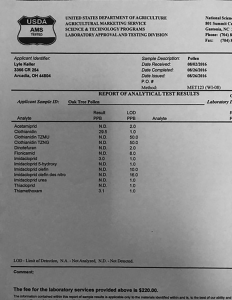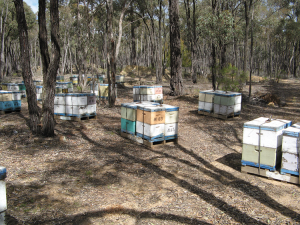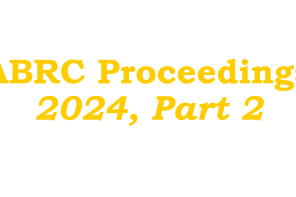By: Ross Conrad
The often heard refrain that Varroa is the primary cause of colony losses associated with CCD is simply not supported by the evidence.
So far in this series, we’ve established that hyper-toxic neonicotinoids are severely damaging wild pollinator populations and that the numerous studies showing these pesticides harm honey bees are stacking up like cord wood. Unfortunately the evidence is also quite clear that neonicotinoids are harming honey bees in the field as well as in the lab, and thus devastating colonies in much the same way as the wild pollinators.
Colony numbers increasing
Evidence that neonicotinoids are harming honey bees in the field is a bit confusing, a factor that proponents of pesticides are quick to latch onto. While yearly colony losses by beekeepers remain at an all-time high, the total number of managed honey bee colonies have been increasing in recent years both within the U.S. and world-wide. How could this be? Honey bees are exposed to neonics in the same ways that most other pollinators are exposed. Being insects, we know that honey bees are highly vulnerable to the toxic effects of neonicotinoid insecticide exposure. There is also strong evidence that it is not just pollen that is a source of neonicotinoid contamination in colonies, but nectar is also a source of chronic pesticide poisoning of bees.
In October 2017 the journal Science published the results of a worldwide survey of neonicotinoids in honey. After sampling honey from all six continents that honey bees inhabit, researchers reported, “We assessed the global exposure of pollinators to neonicotinoids by analyzing 198 honey samples from across the world. We found at least one of five tested compounds (acetamiprid, clothianidin, imidacloprid, thiacloprid, and thiamethoxam) in 75 percent of all samples, 45 percent of samples contained two or more of these compounds, and 10 percent contained four or five. Our results confirm the exposure of bees to neonicotinoids in their food throughout the world.” (Mitchell, 2017) Researchers found that contamination rates were highest in North America with 86 percent of samples contaminated.
Given all the evidence of impending harm and confirmation of exposure, why are honey bee populations growing and not dramatically declining in a similar manner as native pollinators?
Buffering effects
By all accounts honey bees are in fact being decimated in a similar manner as native pollinators, but colony numbers are being buffered by the effects of these chemicals in two important ways. The first is due to their large colony population size (tens of thousands of individuals in a colony compared to solitary pollinators or hundreds of insects in a bumble bee colony for example). When a hive of honey bees losses 10,000 bees due to pesticide exposure, there may be tens of thousands of bees left to carry on – all the beekeeper observes is that the hive is not as strong and vigorous as it should be. Additionally, the large numbers of bees in a colony can mask (in the short term) the fact that following exposure, individual bees are not as long-lived as usual.
Another way the honey bee appears to be buffered from the effects of pesticides is by the fact that beekeepers are covering up for the pesticide’s effects. This occurs when the conscientious beekeeper: treats their bees for diseases after pesticides have weakened the bee’s immune system making them vulnerable; treats for Varroa mites after pesticides weaken brood immune systems allowing mite populations to increase faster than normal, or when pesticides kill some but not all the bees thereby increasing the ratio of mites to bees in the hive; replaces the queen when pesticides cause the queen to fail or be superceded; or feeds the bees when pesticides inhibit the ability of the bees to forage effectively for food. As mentioned last month, the primary issue with many pesticides and neonics in particular, is not just acute toxic exposure but the chronic, sub-lethal doses that bees are exposed to over time.
Beekeeper experience: The Story of Lyle Keller
Ever since 2007 when David Hackenberg of Lewisburg, PA sounded the alarm over the devastation he was experiencing in his hives, scores of beekeepers have suffered a similar fate. One recent example is the story of Lyle Keller of Arcadia, Ohio who has been keeping bees since 1973. Keller worked for 30 years as a commercial beekeeper. He is the owner and operator of Keller Bison and Bees pollinating cherries and apples in Michigan and producing honey while running about 2,000 colonies at his peak. In 2016 Keller had 1,000 colonies, today he is lucky if he has 20 left. An exceptionally wet spring in 2016 prevented the farmers in his area from planting until May 23rd when the fields finally dried out and all the farmers planted at the same time releasing large amounts of neonicotinoid impregnated dust from their treated seeds. Three days later Keller reports that he had three inches of dead bees littering his apiaries. By mid-June he had about 600 living colonies left and the bees were weak and demoralized. He tried drenching his hives with essential oils and by July his bees seemed to have rebounded. Unfortunately, the colonies were not strong enough to survive Ohio’s Winter and almost all his hives were dead by Spring.

Lyle Keller learned that it is always advisable to send samples to more than one lab when having pesticide residue testing done. Unacceptably high concentrations of neonicotinoids were found in the samples tested by USDA and EPA labs, while the results from state testing of similar samples found no contamination at all.”
When the initial die-off of his bees occurred, Keller says his beekeeping income “came to an abrupt halt.” Keller knew that the best thing he could do under the circumstance was to have samples tested in order to identify the cause of death and help prevent other beekeepers from suffering the same fate. He had his Ohio County Extension Agent pull samples to test in house and at the same time he sent samples to North Carolina’s USDA Agricultural Research Services (ARS) lab in Raleigh as well as Georgia’s EPA lab in Atlanta. The results of EPA and USDA analysis found alarmingly high levels of several neonicotinoids that are commonly used for agricultural seed treatment. The state of Ohio meanwhile would not release the results of its testing until after Keller got his state Senator to intervene to release the results. Interestingly, the state of Ohio reported finding absolutely no pesticide contamination in any of the samples it tested. Personally I am not sure what is more disturbing, the high levels of neonics found in samples of Mr. Keller’s bees or the apparent attempt by the state of Ohio to sweep the entire incident under the rug.
Mr. Keller had been planning on selling his beekeeping operation in retirement. Today, he can’t even find anyone who wants to purchase his empty equipment due to concerns about contamination. It is heartbreaking that he can’t continue to keep bees commercially and he finds it frustrating and “irritating that this can happen to somebody.” Keller told me that “if we don’t do something relatively soon there’s not going to be a commercial bee industry anymore.”
Costs to beekeepers
Even when the impacts of acute exposure don’t put beekeeping operations out of business, the constant drag on the health of honey bee colonies from sub-lethal exposure costs beekeepers money as they spend extra time and resources treating for pathogens and pests, having to feed and re-queening hives all in an effort to keep their bees alive. The only reason the beekeeping industry has not collapsed already is because beekeepers have developed numerous approaches to prop up colonies and reduce stress in various areas (nutrition, pathogen exposure, mite predation, etc.) in the attempt to make up for the acute and chronic stress colonies are suffering from pesticide exposure.
While I have previously reported on the wide-spread use of essential oil drenching in response to stress induced CCD symptoms (see Bee Culture March 2010), some beekeepers will sacrifice much of the honey harvest to insure that their bees are fed natural honey and pollen during periods of prolonged dearth. This is more expensive but preferable to feeding sugar syrup and protein patties, since the colony’s immune system tends to be stronger when subsisting on a natural diet rather than an artificial one. (DeGrandi-Hoffman 2010, Mau 2013) Other beekeepers will take their weak hives and split them, giving each split a new queen. Such efforts cost beekeepers money and labor, directly reducing profitability of the beekeeping operation than if colonies were not exposed and were all strong and healthy to begin with. The current recommendation that beekeepers rotate out their old combs due to pesticide residue and pathogen build up also creates additional costs. Combs are a large investment in time, money, and honey on both the part of the beekeeper and the honey bee. Beekeeper actions such as these have caused reports of CCD symptoms to decline while allowing chemical companies to maintain their billion dollar market by forcing beekeepers to absorb the financial side effects of pesticide use as I have pointed out on these pages in the past. (Bee Culture May 2016)

Despite not being exposed to Varroa mites, Australian bees, such as those found in this beeyard in the Australian outback, are starting to experience some of the same symptoms that colonies have been suffering from in the rest of the world where neonicotinoid insecticides have been in common use.
Arguments in defense of Neonics don’t hold water
The proponents of pesticides have long pointed to the continent of Australia as proof that the primary problem facing the honey bee is the Varroa mite, not pesticides. Australia is the only continent upon which honey bees are found, but the Varroa mite has yet to become widely established. Australia meanwhile has seen neonicotinoid pesticides used on the continent for many years and no CCD-like problems have been reported by beekeepers in all that time – until recently. According to Des Cannon, the editor of the Australasian Beekeeper magazine headquartered near Queanbeyan, in south-eastern NSW, Australia, “In regard to bee losses in Australia, there have been no documented large scale losses of bees such as in Europe or the U.S. Any localized bee losses (of the order of 25%) have generally been attributed to Nosema (primarily Nosema apis), but losses here are generally less than 15% (15% is regarded as high but natural). Victoria did have a large problem with Nosema in August a couple of years ago.
“That said there have been many anecdotal stories of bees failing to thrive on Canola, and commercial beekeepers are telling me that they now regard losses of 30% as becoming normal. I am also being told by two of our most respected beekeeping families that they now requeen any hive that has been to Canola. My own experience, and this is backed up by the anecdotal evidence, is that this trend toward ‘lack of thriving’ has been associated with the increase in use of neonics. The farmers I talk to outside beekeeping have told me they find it almost impossible to obtain Canola seed that has not been seed coated,” says Cannon.
Cannon recognizes that, “In the past, bees would always be at swarming pitch after Canola, but over the past few years that has definitely not been the case. Many beekeepers have blamed the Gaucho seed treatment of Canola seed for this, but there has been no scientific evaluation of these claims. There could just as easily have been a shift in the bee’s ability to utilize the Canola as a result of changes in Canola varieties, for example.
He continues, “I think it would also be fair to say that beekeepers in Australia are fortunate that we produce 70% of our honey from native flora, particularly Eucalyptus, and that these plants also provide a good supply of high-quality pollen. We also have a diverse range of weeds in our agricultural environment. There is little need for supplementary feeding in Australia (except on some species of Eucalyptus), although beekeepers would benefit from targeted supplementary feeding – myself and some other commercial beekeepers have certainly done so, and reaped economic benefit; but Australian beekeepers generally have not accepted that there is economic gain to be made. This aside, the bees survive generally in a good state of nutrition, which reduces the possibilities for large scale bee losses. I would add, however, that the landscape is changing with climate change, mainly because of changing rainfall patterns.”
Thus it appears from Des Cannon’s comments that although the majority of bees in Australia forage on native flora (eucalyptus), the increasing use of neonicotinoid treated Canola seed seems to be having an impact on the overall health of the honey bees down-under, undermining the argument that the situation in Australia is proof that Varroa is the primary cause of the world-wide decline in honey bee health and not pesticides.
A similar scenario appears poised to play out on the island nation of Cuba, where honey bees have been thriving for decades in an environment where Varroa are common-place, but pesticide use has, until recently, been non-existent. (Bee Culture April 2017)
Correlation Does Not Prove Causation
Clear evidence that the dramatic increase in honey bee colony losses coincides with the rapid increase in the use of neonicotinoid pesticides comes in the form of a study published in the journal Science and Technology. This research documents a dramatic increase in neonicotinoid use right around the time the U.S. beekeeping industry started experiencing a dramatic increase in honey bee colony losses. (Douglas and Tooker, 2015) Similar findings have been uncovered in Europe where “…a positive relationship with honey bee colony losses such that increased regional usage (of imidacloprid) was linked to higher honey bee colony losses (Budge, 2015)
In every country where neonicotinoid insecticides have been introduced, mass bee deaths and hives that “fail to thrive” have eventually followed. In rare places where they are not used, which besides Cuba include The Hebrides islands off the West coast of Scotland and the Orkney Islands to the North of Scotland, no mass bee deaths have occurred. Apologists for the pesticide industry are quick to point out that such correlations of neonicotinoid use and honey bee losses do not prove causation. However, it is also true that you can’t have causation without correlation. We know that these insecticides are highly toxic to honey bees; we know that the bees are getting exposed to these chemicals through numerous channels; and we know that despite the best efforts of beekeepers, honey bee colonies are dying and dwindling in record numbers.
Despite all this evidence, you will still hear people claiming that Varroa is the primary cause of honey bee losses. The reality is that Varroa does not kill hives within a few weeks, nor does it leave empty hives and vanished bees. Hives that collapse from Varroa do not show symptoms of delayed scavenger activity, where other bees, hornets, wax moths, or small hive beetles stay away from the collapsing colony for weeks. Nor can Varroa be blamed for the fact that many of the 4,000 or so species of native wild bees in the United States are disappearing much faster than honey bees. Honey bee colonies appear to die from a plethora of diseases, but the evidence strongly suggests that the primary cause behind their deaths is neonicotinoid pesticides. Without an immune system, bees succumb to whatever knocks on the door. Even though scientists have unmasked neonics as a primary killer EPA, USDA, CropLife, the White House, and even state bee inspectors and extension services attempt to sweep it all under the rug. We’ll take a closer look at pesticide regulation and the economic environment that has led us to this moment in beekeeping history next month.
References
Budge, G., et. al., (2015) Evidence for Pollinator Cost and Farming Benefits of neonicotinoid seed coatings on Oil Rape, Scientific Reports 5, Art. no. 12574 doi:10.1038/srep12574
DeGrandi-Hoffman, G., Chen, Y., Huang, E., Huang, M.H., (2010) The effect of diet on protein concentration, hypopharyngeal gland development and virus load in worker honey bees, Journal of Insect Physiology, 56(9): 1184-1191
Douglas, M., Tooker. J.F., Large-scale deployment of seed treatments has driven rapid increase in use of neonicotinoid insecticides and preemptive pest management in U.S. field crops. Environmental Science & Technology, 2015; 150320174253000 DOI: 10.1021/es506141g
Mau, W., Schuler, M.A., Berenbaum, M.R., (2013) Honey constituents up-regulate detoxification and immunity genes in the western honey bee Apis mellifera, Proceedings of the National Academy of Sciences, 110(22):8842-8846
Mitchell, E.A.D., Mulhauser, B., Mulot, M., Mutabazi, A., Glauser, G., Aebi, A., (2017) A Worldwide Survey of Neonicotinoids in Honey, Science 358:109-111











